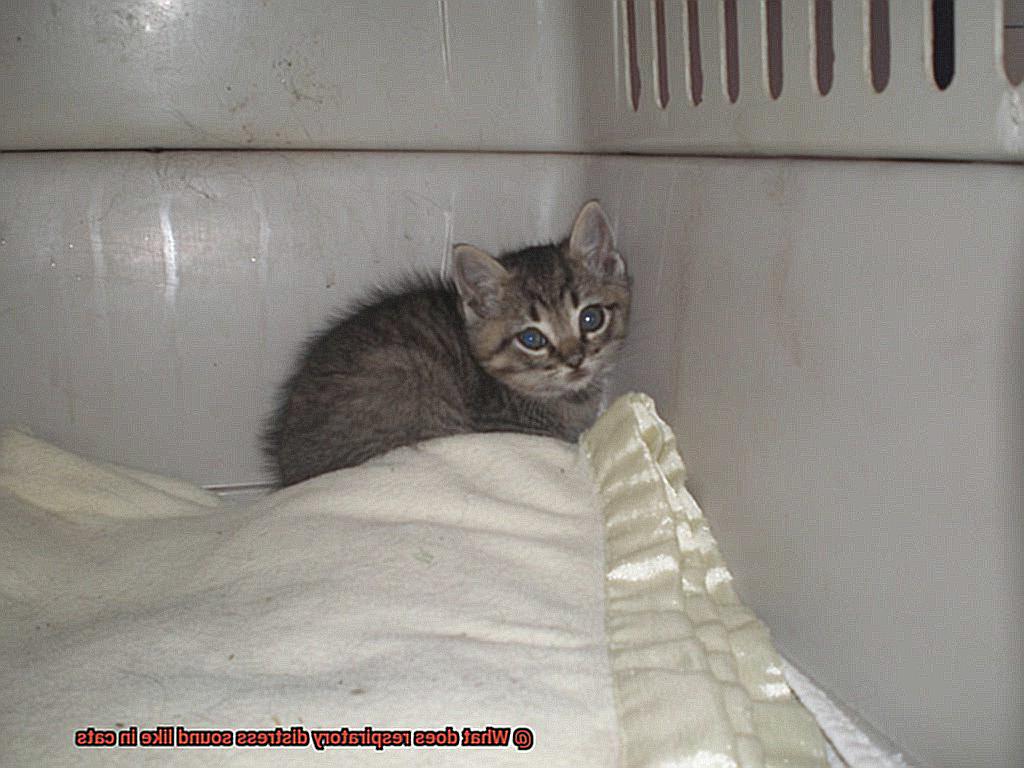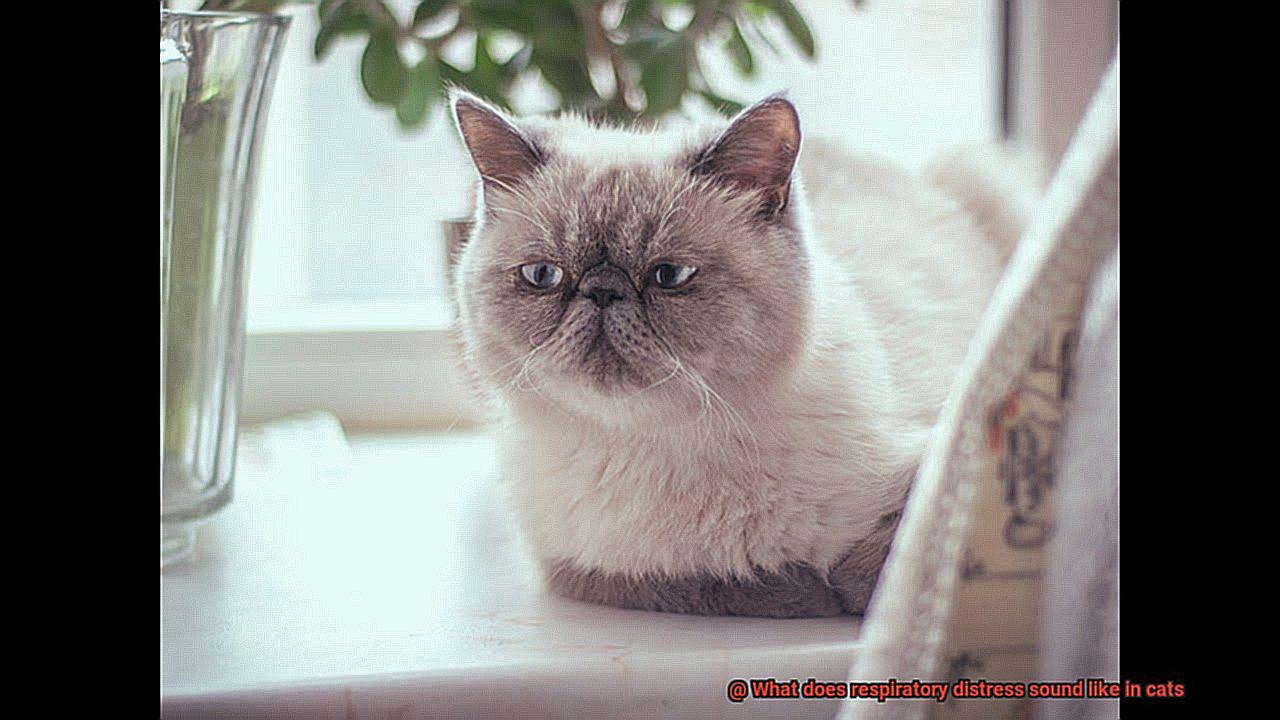Cats are our cuddly companions, but what if your feline friend starts making strange noises while snuggling? What if they sound like they’re struggling to breathe? These sounds could be a warning sign of respiratory distress in cats. It’s a serious condition that can affect any cat, regardless of age or breed. In fact, it’s a medical emergency that demands immediate attention from a veterinarian.
As a cat parent, it’s crucial to recognize the signs of respiratory distress so you can act quickly. The symptoms can vary from mild to severe and include rapid or labored breathing, coughing, wheezing, gagging or retching, and open-mouth breathing.
Respiratory distress in cats has many causes and can result from various underlying medical conditions such as asthma, pneumonia, and heart failure. It can also occur due to an injury or ingestion of a foreign object.
In this blog post, we’ll delve into what respiratory distress sounds like in cats so you can identify it with ease. We’ll also discuss the different causes and treatments available for this critical condition that could save your furry friend’s life. So sit tight and get ready to learn more about how to keep your cuddly companion healthy.
What is Respiratory Distress in Cats?
Respiratory distress in cats is a grave condition that can lead to severe health issues if not detected and treated promptly. It is vital to recognize the signs of respiratory distress in cats so that you can seek immediate veterinary care.

One of the most noticeable indicators of respiratory distress in cats is an abnormal sound when breathing. This can manifest as wheezing, rasping, or a high-pitched whistling noise. The cat may also be experiencing labored breathing, where they are breathing faster than usual or struggling to take deep breaths. In some cases, the cat may also frequently cough or sneeze.
However, it’s crucial to note that not all cats with respiratory distress will make this noise when breathing, and not all cats that make these noises are experiencing respiratory distress. Therefore, it’s essential to monitor your cat closely and seek veterinary attention immediately if you notice any unusual sounds when your cat is breathing.
Other signs of respiratory distress in cats include open-mouth breathing, rapid breathing, shallow breathing, panting, coughing, blue or pale gums and tongue, and an inability to eat or drink. In severe cases, your cat may also show signs of lethargy or collapse.
Respiratory distress in cats can stem from various factors such as asthma, heart disease, infections like feline upper respiratory infection, allergies, and even cancer. Therefore, it’s vital to seek veterinary attention immediately so that the underlying cause of the respiratory distress can be identified and treated appropriately.
Treatment options for respiratory distress in cats may include medication, oxygen therapy, or even surgery in severe cases. With proper treatment and management, many cats with respiratory distress can go on to live long and healthy lives.
Signs and Symptoms of Respiratory Distress in Cats
Cats are susceptible to respiratory problems due to their small airways, which can become obstructed or inflamed easily. It is crucial to recognize the signs and symptoms of respiratory distress in cats and seek veterinary attention as soon as possible to avoid any life-threatening situations.
One of the most common signs of respiratory distress in cats is rapid or labored breathing. If you notice your cat panting or breathing faster than usual, it could be a sign of respiratory distress. Additionally, if your cat is breathing with their mouth open or panting, this is not normal behavior for felines and should be taken seriously.
Coughing or wheezing are also red flags for respiratory distress in cats. If your cat is coughing frequently or making a wheezing sound when they breathe, their airways may be obstructed due to mucus or fluid buildup in the lungs or inflammation of the airways.
In severe cases of respiratory distress, you may notice your cat’s gums and tongue turning blue or purple due to a lack of oxygen in their bloodstream. This is a medical emergency and requires immediate attention from a veterinarian.
Other signs of respiratory distress in cats include lethargy, loss of appetite, and fever. If you notice any of these symptoms along with rapid or labored breathing, it is important to seek veterinary care right away.
What Does Respiratory Distress Sound Like in Cats?

Abnormal breathing sounds are a common indicator and can serve as a warning sign of various conditions, including asthma, bronchitis, pneumonia, and heart disease.
If your cat is experiencing respiratory distress due to asthma, you may hear wheezing or whistling sounds during their breathing. This occurs because their airways become narrow, making it difficult for air to flow freely. Cats with bronchitis, on the other hand, may produce a rattling or gurgling sound while breathing due to inflammation and excess mucus production in the airways.
Pneumonia, which is an infection of the lungs, can cause crackling or popping sounds when your cat breathes. This happens when fluid builds up in the lungs and restricts airflow. Similarly, heart disease can cause fluid accumulation in your cat’s lungs, leading to rasping or gasping sounds while breathing.

It’s essential to note that not all breathing sounds indicate respiratory distress. Some cats may produce snoring or purring-like sounds during relaxation or sleep, which are normal and don’t indicate any health problems. However, if you notice any persistent abnormal breathing sounds in your cat, it’s crucial to seek veterinary care as soon as possible.
Common Causes of Respiratory Distress in Cats
That’s why it’s important to be aware of any signs of respiratory distress in your feline friend. Respiratory distress can be caused by a variety of factors, including infections, allergies, and underlying health conditions. In this blog post, we’ll explore the five most common causes of respiratory distress in cats and what you can do if you suspect your cat may be experiencing this condition.
Upper respiratory infections (URIs): One of the most common causes of respiratory distress in cats is upper respiratory infections. These infections can be caused by viruses or bacteria and are highly contagious. Symptoms include sneezing, coughing, nasal discharge, and difficulty breathing. If you suspect that your cat has a URI, seek veterinary care right away to prevent the spread of infection and ensure prompt treatment.
Asthma: This chronic respiratory condition affects many cats and is characterized by inflammation and narrowing of the airways. This inflammation makes it difficult for cats to breathe and can cause wheezing, coughing, and labored breathing. If you suspect that your cat has asthma, it’s crucial to seek veterinary attention right away to manage the condition and prevent future episodes.
Allergies: Like humans, cats can develop respiratory distress due to allergies to environmental factors such as pollen, dust mites, or cigarette smoke. Symptoms include sneezing, coughing, and difficulty breathing. If you suspect that your cat has allergies, it’s important to identify the allergen and take steps to minimize their exposure. Your vet may recommend medications or other treatments to manage symptoms.
Heart disease: Certain types of heart disease can cause fluid buildup in the lungs, leading to respiratory distress. Symptoms include coughing, labored breathing, and lethargy. If you suspect that your cat has heart disease, it’s crucial to seek veterinary care right away to manage the condition and prevent further complications.
Lung disease: Diseases such as pneumonia or lung cancer can cause respiratory distress in cats. Symptoms include coughing, labored breathing, and lethargy. If you suspect that your cat has lung disease, it’s important to seek veterinary care right away to diagnose the underlying condition and provide appropriate treatment.
Treatment for Respiratory Distress in Cats
Watching your beloved cat struggle to breathe can be a terrifying experience. Respiratory distress in cats can be caused by a variety of factors, such as infections, allergies, or heart and lung disease. However, by promptly seeking veterinary attention and following a tailored treatment plan, you can help your feline friend breathe easy once again.
The first step in managing respiratory distress in cats is to seek veterinary attention immediately. Your vet will conduct a thorough examination to determine the underlying cause and severity of the condition. Treatment options can vary depending on the cause, but here are some common approaches:
If respiratory distress is due to an obstruction in the airway, such as a tumor or foreign object, surgery may be necessary to remove it. In cases where the respiratory distress is caused by an infection, antibiotics may be prescribed to treat the infection and alleviate symptoms.
In some instances, your cat may need oxygen therapy to help them breathe more easily. This could involve providing oxygen through a mask or an oxygen cage. In severe cases of respiratory distress, hospitalization and intensive care may be required. During this time, your cat’s vital signs will be closely monitored, and additional treatments may be administered as needed.
Remember, some treatments for respiratory distress in cats may only provide temporary relief. Additional treatments may be necessary depending on the underlying cause of the condition.
Apart from medical treatment, environmental changes can also help reduce stress on your cat’s respiratory system. This includes minimizing exposure to allergens or irritants in the home, providing a calm and quiet environment for your cat, and reducing physical exertion.
Prevention of Respiratory Distress in Cats
Fortunately, there are a few simple steps you can take to prevent this from happening.
Firstly, keeping your cat’s environment clean and free of irritants is crucial. Regularly cleaning their litter box, vacuuming their living space, and avoiding harsh chemicals or fragrances in the home can significantly reduce the risk of respiratory distress. Additionally, smoking should be avoided around cats as second-hand smoke can cause breathing difficulties.
Maintaining a healthy weight in your cat is also essential for preventing respiratory issues. Overweight cats are more prone to breathing difficulties and other health problems. Provide them with a balanced diet and regular exercise to keep them at an optimal weight.
Regular veterinary check-ups are an important preventive measure for respiratory distress in cats. Your vet will be able to detect any abnormalities or potential problems with your cat’s breathing and recommend specific preventive measures based on their individual needs.
Vaccinations are also crucial for preventing respiratory infections that can lead to distress. Talk to your vet about which vaccines are recommended for your cat’s age and lifestyle.
WT6rhvVYVgg” >
Conclusion
To wrap up, respiratory distress in cats is a serious condition that demands immediate veterinary attention. As a responsible cat parent, it’s vital to be aware of the signs of respiratory distress so you can act quickly. Symptoms may range from mild to severe and include rapid or labored breathing, coughing, wheezing, gagging or retching, and open-mouth breathing.
Respiratory distress in cats can stem from various underlying medical conditions such as asthma, pneumonia, and heart failure. It may also arise due to an injury or ingestion of a foreign object. Therefore, seeking veterinary attention immediately is crucial so that the root cause of the respiratory distress can be identified and treated appropriately.
Abnormal breathing sounds are often an early warning sign of various conditions such as asthma, bronchitis, pneumonia, and heart disease. If you observe any persistent abnormal breathing sounds in your cat or any other symptoms mentioned above, it’s essential to seek veterinary care as soon as possible.
Prevention is always better than cure; keeping your cat’s environment clean and free of irritants is crucial. Maintaining a healthy weight in your cat is also vital for preventing respiratory issues. Regular veterinary check-ups are an important preventive measure for respiratory distress in cats. Vaccinations are also critical for preventing respiratory infections that can lead to distress.

